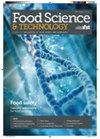Study of the microstructure-property-processing relationship in five potato (Solanum tuberosum) varieties during the frying process based on an automatic classification system using convolutional neural networks
Q2 Agricultural and Biological Sciences
引用次数: 0
Abstract
Our objective was to identify and analyze the microstructural features of five different Peruvian potato varieties in fresh material and a frying process, using a 32-factorial arrangement of temperature and time. Two types of characteristics were measured. The first ones were of microstructural type (i.e., area, perimeter, length of major axis, length of minor axis, roundness, elongation, and compactness) and the second ones were of physicochemical type (i.e., L*, a*, b*, ∆E, acrylamide concentration, fat percentage, moisture percentage, and texture). For this purpose, potato microstructural characterization software was implemented, developing algorithms for image processing and analysis, as well as the classification of structural characteristics. Potato variety was found to exert a significant effect on the microstructural parameters of area, perimeter, major axis length, minor axis length, roundness, and compactness, followed by time, with a significant effect on the microstructural parameters of area, perimeter, major axis length, minor axis length, and compactness. Temperature exerts a significant effect only on roundness and elongation parameters. To observe the relationship between the microstructural and physicochemical parameters, a Pearson correlation was used where it was observed that the correlations between the physicochemical and microstructural variables evaluated were medium to strong.基于卷积神经网络自动分类系统的五个马铃薯(Solanum tuberosum)品种在油炸过程中的微观结构-属性-加工关系研究
我们的目的是利用温度和时间的 32 个因子排列,识别和分析秘鲁五个不同马铃薯品种在新鲜材料和油炸过程中的微观结构特征。测量了两类特征。第一种是微结构类型(即面积、周长、主轴长度、次轴长度、圆度、伸长率和紧密度),第二种是理化类型(即 L*、a*、b*、ΔE、丙烯酰胺浓度、脂肪百分比、水分百分比和质地)。为此,实施了马铃薯微结构表征软件,开发了图像处理和分析算法,并对结构特征进行了分类。研究发现,马铃薯品种对面积、周长、主轴长度、次轴长度、圆度和紧密度等微观结构参数有显著影响,其次是时间,对面积、周长、主轴长度、次轴长度和紧密度等微观结构参数有显著影响。温度只对圆度和伸长率参数有显著影响。为了观察微观结构参数和物理化学参数之间的关系,使用了皮尔逊相关性,结果表明所评估的物理化学变量和微观结构变量之间的相关性为中等至强。
本文章由计算机程序翻译,如有差异,请以英文原文为准。
求助全文
约1分钟内获得全文
求助全文
来源期刊

Food Science and Technology
农林科学-食品科技
自引率
0.00%
发文量
0
审稿时长
12 weeks
期刊介绍:
Information not localized
 求助内容:
求助内容: 应助结果提醒方式:
应助结果提醒方式:


